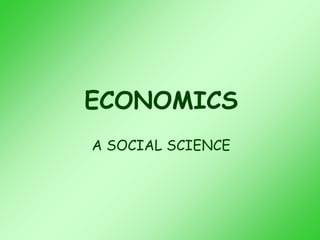
Economics per clil.ppt
- 2. What is economics? • It’s a social science. • It studies wealth production and wealth distribution between different countries and different agents. • It studies different situations through models. chart Pie chart Histogram, bar chart
- 3. It is made up of: • Microeconomics: it studies the behaviour of single economic agents • Macroeconomics: it studies the behaviour of the economy as a whole
- 4. What does it study? • How to satisfy the needs and wants of the consumers through goods and services • The relations among many agents
- 5. Why is it important to study economics? • Everyone (rational agent) knows all the available alternatives very well and tries to get the best result from their action.
- 7. Who are the agents? • Households • Firms • Government • Banks • The rest of the world
- 8. Who are the agents? • ……so economic activity takes place within societies to satisfy the needs and wants of the consumers!!
- 9. • Primary needs are also called NEEDS because we cannot live without them and they are essential for our existence. They are: • Food; • Clothing; • Shelter;
- 10. • Secondary needs are also called WANTS because we do not really need them. They are: • Cars; • Phones; • Holidays; • Computers; • Sport; Life is much easier with these comforts!
- 11. Needs and wants • Our idea of needs and wants is always changing. • As a result of consumers’ increased demands (request) the market now offers (supply) an enormous number of different products. • There are two main types of products: goods and services
- 12. Goods are physical objects we can either see or touch. They can be divided into 2 categories: • Non-durable goods (newspapers, tobacco) • Durable goods (cars, furniture)
- 13. • DIRECT: used directly to satisfy an immediate need (sandwiches); • INSTRUMENTAL: used to produce more goods (wool→ sweaters); • COMPLEMENTARY: goods that better satisfy a need if used together (coffee + sugar) • SURROGATES: different goods that satisfy the same need (butter and margarine). • click here to play
- 14. Services are non-physical products; they are: tourism, education, transport. Services are performances that can be used to satisfy people’s needs.
- 15. PRODUCTION • ….to satisfy needs and wants it is necessary to produce some goods and services
- 16. The meaning of “production”: • Production is the activity that makes use of natural goods to satisfy people’s needs. • A lot of goods can’t be used when they are in their natural state, so they have to be transformed through work and machineries in order to be useful or more useful.
- 17. Production stages • Turning raw materials into finished products • Carrying them from the place of production to the place of consumption • Enabling consumers to buy them where and when they want
- 19. IMPORTANT!!!!! • The production factors are in short supply. As a result, it is important to use resources efficiently, in order to maximise the output that can be produced from them
- 20. Land or natural resources We find them in nature, for example mineral, water, solar power, wood etc. Natural resources are fundamental for the production of all goods
- 21. Labour In economics, labour is the work carried out by human beings. So it refers to the number of people working and to their skills.
- 22. Capital It is the money invested to run a business. It is used to build factories, machinery, vehicles, buildings and equipment and anything that is needed to produce goods or services (this is what makes it a factor of production).
- 23. Organization It is the phase that coordinates all the factors. Through the organization an enterprise combines the factors to obtain the most favorable economic results.
- 25. Economics sectors Business activity is the process of transforming inputs into outputs by adding value. There are four main sectors of business activity:
- 26. PRIMARY SECTOR It includes business organisation regarding the production or extraction of raw materials from natural sources
- 27. Industries in the primary sector include: • Farming and agriculture • Forestry • Fishing • Oil extraction • Mineral extraction
- 28. decline • There is a constant decline in employment in many primary activities, due to the use of new technologies.
- 29. SECONDARY SECTOR • It includes manufacturing industries which make finished products as well as construction industries.
- 30. Industries in the secondary sector include: • Metal and mineral products • Chemicals and artificial fibres • Engineering and car production • Food, drink and tobacco • Textiles, clothing • Building • Civil engineering (roads, etc.)
- 31. • Employment in the secondary sector is declining too, due to the competition from newly industrialised countries in the Far East, such as China, Taiwan etc.
- 32. TERTIARY SECTOR • It includes service industries that get their name because they provide a service rather than a product.
- 33. Industries in the tertiary sector include: • Retailing • Distribution • Hotels and catering • Banking and financial services • Post and telecommunications • Education • Health services • Public administration
- 34. Tertiary advanced sector The advanced tertiary sector is represented by new information technologies. Companies dealing with telecommunications, information technologies, media consulting services, and information processing are all part of the advanced tertiary sector. The term “advanced tertiary” was coined in the last decades to distinguish between the companies offering service at